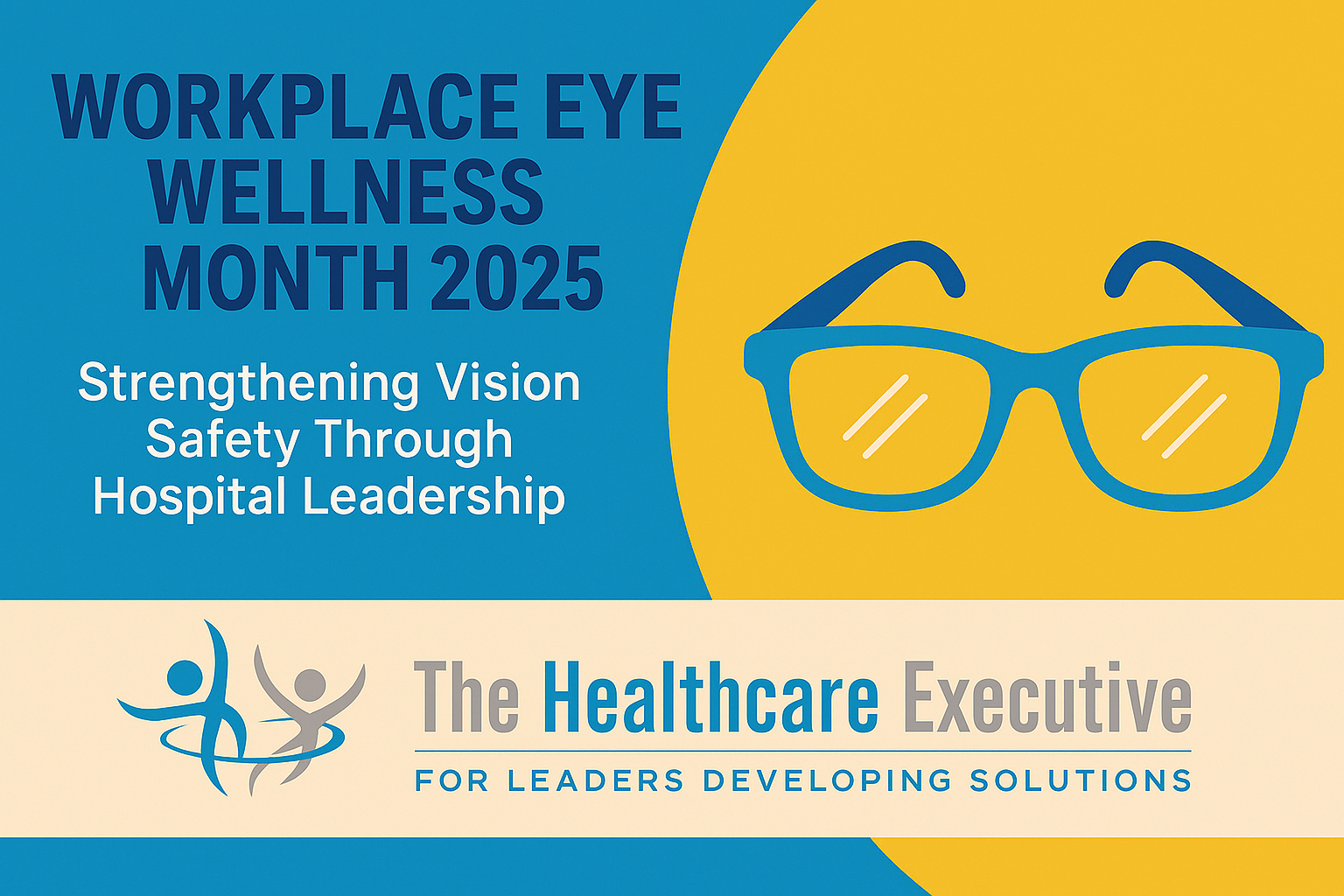Workplace Eye Wellness Month 2025: Strengthening Vision Safety Through Hospital Leadership

- Posted by Greg Wahlstrom, MBA, HCM
- Posted in Health Observance Calendar
Hospital Executives Must Prioritize Digital Eye Health, Ergonomics, and Preventive Vision Strategies for the Clinical Workforce
Published: March 7, 2025
Workplace Eye Wellness Month, observed each March, serves as a timely reminder that vision health is essential to the overall safety and productivity of healthcare teams. In today’s healthcare settings, prolonged exposure to digital devices, poor lighting conditions, and insufficient ergonomic design can create the perfect storm for digital eye strain. According to the CDC and NIOSH, thousands of occupational eye injuries occur each day, but the majority are preventable with better workplace design and leadership awareness. Eye fatigue, blurred vision, and headaches are just a few symptoms impacting nurses, physicians, and administrative staff across all departments. At Mayo Clinic, executives have implemented systemwide screening protocols and incorporated vision metrics into employee wellness evaluations. Hospital leaders must realize that digital eye strain is not just a health issue—it’s a productivity risk that impacts operational performance and care quality. By integrating vision safety into occupational health standards, executive teams can proactively safeguard staff resilience and satisfaction. Workplace eye health should be an executive priority, not an afterthought.
One of the most prevalent issues in today’s clinical environments is computer vision syndrome, also known as digital eye strain, which affects more than half of all healthcare employees. Healthcare professionals routinely engage in eight or more hours of screen use per day—often without appropriate visual breaks or ergonomic safeguards. At Johns Hopkins Medicine, eye strain prevention has been built into onboarding and continuing education for clinical staff. Hospital executives should take inspiration from such models and adopt formal policies that ensure workstation adjustments, glare protection, and access to blue light–filtering tools. Enforcing the 20-20-20 rule—every 20 minutes, take a 20-second break to look at something 20 feet away—can be embedded into shift workflows as a team norm. Executives must also ensure staff have access to high-quality safety eyewear and make visual comfort part of ongoing environmental safety assessments. By empowering employees with resources and routines to protect their vision, leaders demonstrate a commitment to long-term workforce health. Vision-friendly workplace culture starts at the top and affects every screen, hallway, and operating room.
The clinical consequences of unaddressed vision strain extend well beyond comfort—they can jeopardize patient safety and clinical accuracy. Visual fatigue reduces focus, delays decision-making, and increases the risk of medication or documentation errors in high-stakes settings. Hospital executives should conduct periodic lighting audits and ergonomic reviews of departments with high visual demands, such as emergency rooms, radiology labs, and surgical theaters. At UCHealth, investment in ANSI-compliant eyewear, ambient lighting upgrades, and visual rest zones has resulted in measurable reductions in reported fatigue. Cross-disciplinary coordination between facilities teams, IT departments, and clinical managers can lead to better equipment placement, screen resolution standards, and lighting design. Hospital leaders must treat vision safety as part of human-centered design, ensuring that the work environment supports cognitive performance as well as physical safety. Vision must be elevated in every executive discussion about safety culture and clinical optimization. Leadership drives the blueprint—and the clarity—with which care is delivered.
Workplace vision wellness is also a health equity issue. Employees working night shifts, in lower-compensated roles, or across dispersed outpatient facilities often lack access to vision assessments and protective gear. According to the Prevent Blindness Vision Health Equity initiative, vulnerable worker groups are less likely to receive prescription safety glasses or vision health screenings. Hospital executives must examine access gaps and ensure that all employees—not just clinical staff—receive equal resources for protecting their sight. This includes custodial teams, food service workers, lab technicians, and others who may face occupational exposures without appropriate vision supports. Community partnerships with optometry providers, employer-sponsored eye exams, and flexible vision benefits can strengthen both inclusion and workforce retention. Equitable eye health practices improve morale and reduce absenteeism, making them a win-win for both staff and the system. Leadership means ensuring that vision protection extends to every corner of the organization.
Workplace Eye Wellness Month 2025 invites hospital executives to champion a new vision for vision itself. From screen policy implementation to equitable access and facility design, every decision made at the executive level influences how staff see—literally and professionally. Just as hand hygiene and infection control are foundational to safety, so too should be vision protection in all workspaces. Executives must embed visual wellness into workforce strategies, safety dashboards, and facility master plans. As leaders pursue operational excellence, they must remember that seeing clearly is integral to thinking clearly, acting safely, and caring effectively. Sight is not just a human faculty—it is an organizational asset. And like every strategic asset, it must be protected and prioritized by those in charge.
Discover More on Occupational Wellness Leadership
Explore how your executive team can build enduring wellness frameworks with vision health, safety, and performance at the center.
Internal Links
- The Healthcare Workforce Crisis: Executive Solutions That Actually Work
- The 2025 Regulatory Roadmap: What CEOs Must Prepare For Now



